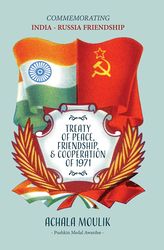In India the mood was something like mourning, a dear friend had passed away…. India feels orphaned—ideologically, strategically, economically,” wrote American writers Susanne and Lloyd Rudolph in November 1991, in the Christian Science Monitor magazine, about India’s response to the disintegration of the Soviet Union.
In international relations, there are no permanent friends or permanent foes, but only permanent interests, say the apostles of pragmatism. But that theory would fail to explain the friendship India had with the Soviet Union. Former bureaucrat Achala Moulik’s new book, Treaty of Peace, Friendship and Cooperation of 1971, offers the nuances of this fascinating relationship.
Though the landmark treaty of August 9, 1971—that saw India’s departure from the Non-Aligned Movement—is the central focus of the book, Moulik goes beyond that to offer a larger picture and history of the bond shared between India and Russia. The author does not hesitate to present her admiration for the Soviet Union in the book.
1955 was a crucial year for the India-Soviet bond. That year prime minister Jawaharlal Nehru visited Russia, and top Soviet leaders Nikita Khrushchev and Nikolai A. Bulganin visited India. Moulik observes that these state visits produced new foreign policies in both countries. India was allowed to keep her non-aligned status while continuing to be a close friend of the Soviet Union. According to Moulik, this was made possible because the Soviets did not demand anything in return—except friendship. Finally, in 1971, an impending war with Pakistan made India ink a treaty with the USSR—India’s first political treaty with another country. According to Moulik, the treaty was a result of Pakistan’s “folly and intransigence”.
The end of the Soviet era brought up issues in India-Russia cooperation in several sectors, especially defence. Boris Yeltsin, the first president of the Russian Federation, wanted to water down the 1971 treaty. And in 1993, India and Russia signed a modified version of the treaty—with no security clauses on aggression by the Americans or Chinese.
But within five years, both countries would revive the strength of their historic treaty. And, the next two decades would see India-Russia cooperation expanding in different sectors. Moulik points out that the arms sale is the “pivotal pillar”in this relationship. However, since 2014, India has looked to the US and Israel for arms purchases. This has made Russia also seek new friends. Despite this, the author calls India a time-tested friend of Russia. She notes that Indo-Russian friendship is based on a bond of amity and mutual respect, which “outlasts the buying and selling of arms and transient partnerships of temporary benefits”.
Moulik’s literary flair is commendable as she makes a very serious subject an easy and enjoyable read. And, she fully succeeds in passing on her optimism about the future of India-Russia ties to the reader.
TREATY OF PEACE, FRIENDSHIP & COOPERATION OF 1971
By Achala Moulik
Publisher: AuthorsUpFront
Price Rs495; Pages 246


